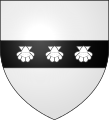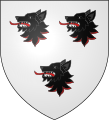Argent
This articleneeds additional citations forverification.(July 2014) |
| Argent | |
|---|---|
| Class | Metal |
| Non-heraldic equivalent | Silveror (white) |
| Monochromatic designations | |
| Hatchingpattern | |
| Trickingabbr. | a., ar., arg. |
| Poetic designations | |
| Heavenly body | Moon |
| Jewel | Pearl |
| Virtue | Innocence |
Inheraldry,argent(/ˈɑːrdʒənt/) is thetinctureofsilver,and belongs to the class of lighttincturescalled "metals". It is very frequently depicted aswhiteand usually considered interchangeable with it. In engravings and line drawings, regions to be tincturedargentare either left blank, or indicated with the abbreviationar.
The name derives fromLatinargentum,translated as "silver"or" whitemetal".The wordargenthad the same meaning in Old Frenchblazon,whence it passed into the English language.
In some historical depictions ofcoats of arms,a kind of silver leaf was applied to those parts of the device that were argent. Over time, the silver content of these depictions hastarnishedand darkened. As a result, it can sometimes be difficult to distinguish regions that were intended as "argent" from those that were "sable".This leaves a false impression that therule of tincturehas been violated in cases where, when applied next to a dark colour, argent now appears to be sable due totarnish.
Argent versus white[edit]
Arthur Charles Fox-Daviesargued in his bookThe Art of Heraldrythat, though extremely rare, the colour white existed as an independent tincture in heraldry separate from argent. He bases this in part on the "whitelabels"used to differentiate the arms of members of theBritish royal family.However, it has been argued that these could be regarded as "white labels proper", thus rendering white not a heraldic tincture.[1]
Poetic meaning[edit]
The different tinctures are traditionally associated with particular heavenly bodies, precious stones, virtues, and flowers, although these associations have been mostly disregarded by serious heraldists.[2]In addition to the metal silver, Argent is associated with:
- Of jewels, thepearl[2](or sometimes crystal)[3]
- Of heavenly bodies, theMoon[2]
- Of virtues,innocence[2]
Gallery[edit]
-
Arms of Guillemin family (France)
-
Arms of the municipality ofDegerfors,Sweden.
-
Arms of Visdelou family (France)
-
Arms of Le Lagadec family (France)
-
Arms of Jégou family (France)
References[edit]
- ^"The Scottish Heraldry Forum Message: Paton - help".Archived fromthe originalon 2003-09-10.Retrieved2012-01-01.
- ^abcdWoodcock, Thomas;Robinson, John Martin(1988).The Oxford Guide to Heraldry.Oxford:Oxford University Press.pp. 53–54.ISBN0-19-211658-4.
- ^Elvin, Charles Norton (1889).A Dictionary of Heraldry.London: Kent. p. 46.





